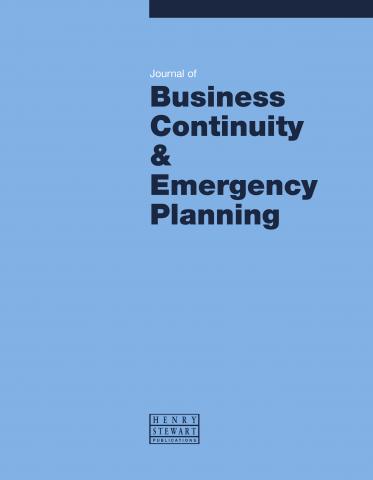"I just got my hard copy of the Journal and the article in there on Industrial Control Systems cyber risk is excellent! Well done throughout, you are to be commended for setting the bar at such a high professional level in the inaugural issue."
Volume 11 (2017-18)
Each volume of Journal of Business Continuity & Emergency Planning consists of four quarterly 100-page issues. The articles and case studies published so far in the current volume, Volume 11, are:
Volume 11 Number 4 (Summer 2018)
-
Editorial
Lyndon Bird, Editor and Chair, DRI International Future Vision Committee -
A metrics framework to get and keep management engaged
Scott Ream, Co-founder and Shane Mathew, Leader for Professional Services, Virtual Corporation -
Communication in a crisis in UK ambulance services: What is needed to improve incident communication?
Oliver Tovey, Resilience Officer, South Western Ambulance Service NHS Foundation Trust, Joshua Tolson, Business Continuity Manager, South Central Ambulance Service NHS Foundation Trust and Angela Vinand, Business Continuity Manager, Yorkshire Ambulance Service NHS Trust -
Leveraging history to improve crisis response
Joan H. Landry, Owner, JL Consulting -
The importance of critical thinking skills in disaster management
Joseph Albanese, Senior Scientific Advisor, and James Paturas, Director, Yale New Haven Center for Emergency Preparedness and Disaster Response -
A preliminary analysis of high-stakes decision-making for crisis leadership
Terry Oroszi, Assistant Professor, Boonshoft School of Medicine, Wright State University -
Embracing informal stakeholder conversations for evidence-based crisis response: Two work processes based on crisis intelligence
Stijn Pieters, Co-founder and Managing Partner, and Tim Van Achte, crisis management support, PM Risk•Crisis•Change -
Building resilient organisations: Proactive risk management in organisations and their supply chains
Marc Siegel, M Siegel Associates
Volume 11 Number 3 (Spring 2018)
-
Editorial
Lyndon Bird, Editor and Chair, DRI International Future Vision Committee -
Outsourcing critical financial system operations
Nora Cox, Chief Risk Officer and Jan Pilbauer, Executive Director, Payments Canada -
Preparing for campus demonstrations and protests: Four key focus areas
Darrell L. Darnell, Senior Associate Vice President for Safety and Security, George Washington University -
The true value and return on investment of business continuity
Regina Phelps, CEO and Founder, Emergency Management & Safety Solutions -
Business continuity and risk management at a strategic level: Case study of the Flemish government
Joris Bouve, Crisis Manager, Herman-Peter Steens, Crisis Manager, and Martin Ruebens, Secretary-General, Government of Flanders -
A customer-insight led approach to building operational resilience
Fi Passey, Head of Operational Resilience, Nationwide Building Society -
Business continuity and disaster management within the public service in relation to a national development plan
Cliff Ferguson, Director of Strategy and Policy, South African Government Pensions Administration Agency -
Implementing a community recovery programme
Paul Hendy, Community Support and Recovery, Scottish Flood Forum -
Managing stress in a crisis
Alison Wright-Reid -
Improving disaster outcomes with better decision making
Ronda Oberlin, Hazard Mitigation Coordinator, Lansing Office of Emergency Management
Volume 11 Number 2 (Winter 2017/18)
-
Editorial
Lyndon Bird, Editor and Chair, DRI International Future Vision Committee -
Post-event reviews: Using a quantitative approach for analysing incident response to demonstrate the value of business continuity programmes and increase planning efficiency
Karthik Vaidyanathan, Senior Risk Manager, Microsoft -
How Belfius Bank’s response to the terrorist attacks in Brussels helped embed business continuity in the company culture
Ludo Jappens, Business Continuity and Crisis Management Coordinator, Belfius Bank Belgium -
The Fort McMurray, Alberta wildfires: Emergency and recovery management of healthcare services
David Matear, Executive Director, Interior Health West -
Best practice vendor risk management in today’s interconnected world
Ian Beale, Principal Executive Advisor, Gartner -
Enhancing infrastructure resilience through business continuity planning
Ronald Fisher, Director, Homeland Security Division, Idaho National Laboratory, Michael Norman, Director, Infrastructure Information Collection Division, Department of Homeland Security and Mary Klett, Solutions Architect, Homeland Security Division, Idaho National Laboratory -
Coordinating management disciplines to build operational resilience in response to a major crisis situation
Marcin Drachal, Global Business Continuity Management, JLL -
Developing a research-specific emergency management programme for municipal resilience following the 2013 flood in southern Alberta
Charles Bowerman, Planner, Calgary Emergency Management Agency, The City of Calgary
Volume 11 Number 1 (Autumn/Fall 2017)
-
Editorial
Lyndon Bird, Editor and Chair, DRI International Future Vision Committee -
Active-shooter events in the workplace: Findings and policy implications
M. Hunter Martaindale, Director of Research, William L. Sandel, Research Specialist & J. Pete Blair, Executive Director, ALERRT Center at Texas State University -
Decision-making in crisis: Applying a healthcare triage methodology to business continuity management
Bethany Moore, Senior Consultant & Eric A. Bone, Zone Director, Emergency/Disaster Management, Alberta Health Services -
Effective crisis decision-making
Holger Kaschner, Head of Competence Center Business Continuity and Crisis Management, ACG Automation Consulting Group -
Does integration matter? A holistic model for building community resilience in Pakistan
Shesh Kanta Kafle, Disaster and Climate Change Study Centre -
The capability and constraint model of recoverability: An integrated theory of continuity planning
David Lindstedt, Founder, Readiness Analytics -
Rebooting healthcare information technology downtime management
Julie Bulson, Director, Emergency Preparedness, Mark Van Dyke, Manager, Emergency Preparedness & Nicole Skibinski, Manager, Information Systems, Spectrum Health -
Academic continuity planning in higher education
Cheryl Regehr, Vice-President and Provost, Sioban Nelson, Vice-Provost, Academic Programs and Vice-Provost, Faculty & Academic Life and Angela Hildyard, Special Advisor to the President and Provost, University of Toronto -
Determining the appropriate strategies for emergency planning through AHP-SWOT
Omid Kalatpour, Assistant Professor, Hamadan University of Medical Sciences


